In order for your website to be live on the Internet, it needs to be hosted.
If you’re creating a website for the first time, move “set up hosting” to the top of your to do list, if it’s not already there.
Already own and operate a website? Did you rush into a plan without understanding how everything worked first? Maybe you feel like you’re fine with the host you picked at random. Makes sense — until you run into a problem with your website, you might not even think twice about your hosting plan. However, you don’t want to wait until that happens. It’s better to educate yourself on web hosting now so you can find the best option before anything goes awry. This will make your life much easier down the road.
Regardless of your situation, you’ve come to the right place. This beginner’s guide on web hosting will help you feel confident picking the host that’s right for you and your goals.
What is web hosting?
Let’s start with the basics. What exactly is web hosting? How does web hosting work?
Websites are hosted on servers. In simple terms, a server is a very powerful computer that does only one or two simple services, hence the name server. The type of server we’re interested in stores websites and delivers them to people over the internet. Your web host provides the server space and the technology for your website to be accessed on the Internet. It’s the process that allows someone to search for your site or enter your URL into their web browser to see your page online.
Everything that your website contains is stored and accessed through the web host. I’m referring to things like images, videos, files, text — everything.
Web hosting and data centers are often confused with one another. While the two are similar and work together, they are not quite the same. Web hosting refers to the servers that host websites or the hosting companies that provide you with server space. Data centers are the physical facilities where those servers are located.
Web hosting types
There is no one-size-fits-all plan for web hosting. It’s like buying a car. You don’t just walk into a dealership and say, “I’ll have a car please.”
What kind do you want? You need to decide if you want a sports car, sedan, coupe, hybrid, SUV, electric, diesel, automatic transmission, manual transmission, etc.
Fortunately with web hosting, you don’t have that many options to choose from. There are four main types of hosting.
- Shared
- VPS
- Dedicated
- Cloud
I’ll explain how each one of these works and what type of website would need that level of hosting, so you can decide which option is best for you.
Shared hosting
First, shared hosting. With this method, your website shares server space with other websites. Here’s a diagram that shows how shared web hosting works compared to the other web hosting types:
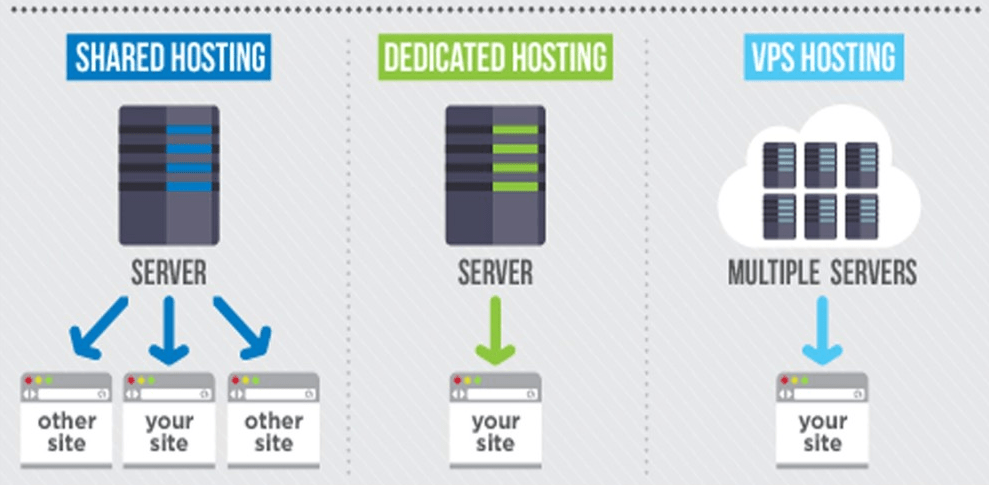
Since you’re sharing a server with other websites, this will be the most cost-effective method. Think of it like taking the bus to work instead of driving your own car. The bus will be less expensive, but you’ll be making some stops along the way to your destination in order accommodate other people.
While I don’t necessarily have a problem with shared hosting, you could potentially run into problems down the road as your website grows and gets more traffic. High spikes in traffic can impact loading time and even lead to error messages for people trying to access your site. The performance of your website can be affected by traffic to other sites on the same shared server. So, just like when you’re on the bus, there may be a ton of other people requesting stops, slowing down your commute. Or, it might be just you and the driver. You’re saving money, but you have less control of the quality of the experience.
Who is shared hosting best for?
Shared hosting is a common option for beginners and entry-level websites. It’s affordable and doesn’t require much technical knowledge. If this sounds like your situation, you’re probably a good candidate for shared hosting. (You can also upgrade later on, when your website traffic grows.)
VPS hosting (Virtual Private Server)
VPS hosting is the next step up from shared hosting. With this option, one server is basically split into multiple virtual servers. The main server is shared with other websites, but each site is given its own virtual server. Since fewer websites share the main server, page load times will be much faster with VPS hosting. Since fewer websites share the main server, page load times will be much faster with VPS hosting.
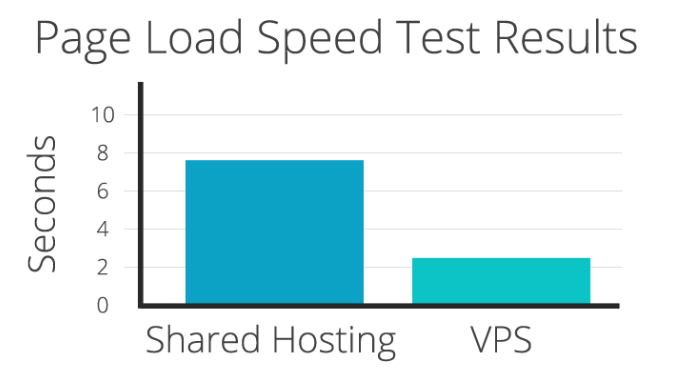
It’s definitely important for you to understand the principles that boost your website loading time since this will ultimately have an impact on your conversions.
It’s not quite as good as dedicated hosting, but it’s better than shared hosting and gives you, the website owner, more control. If you go with this option, you’ll have complete root access and more control at the server level. But if you’re expecting high volumes of traffic, VPS hosting can still be limiting.
I’d compare it to using a car-sharing service: it’s faster than taking the bus, but you’re still limited in some ways.
Who is VPS hosting best for?
Even small websites with lower volumes of traffic can benefit form VPS hosting. If your site has lots of visual elements like images and videos that could potentially slow down the loading time, you’ll be better off with VPS hosting than a shared host.
Dedicated server hosting
Dedicated servers are yours and only yours. They are more expensive than the other options we’ve looked at so far, but the premium pricing comes with added benefits. It’s like owning your own car, as opposed to taking public transportation. You are in control of everything.
Since you’re the only website on this server, you have complete technical control. This allows you to implement a greater range of software on your website. Downtimes should be minimal since you don’t have to worry about traffic from other sites impacting your site. And, your load time is only impacted by your site — not any other sites.
Depending on your hosting plan, you might be able to upgrade from a shared server to a dedicated server when your website grows without having to start over from scratch. I recommend looking for this room to grow when you sign up for a plan. Migrating isn’t any fun, and neither is capping your site’s success.
Who is dedicated server hosting for?
Dedicated servers are for sites with higher volumes of traffic. If you have an ecommerce platform and want to make changes to the server based on your ecommerce software, you should consider going with a dedicated server.
Cloud hosting
According to Statista, the cloud computing and hosting market has been growing for the last decade or so.
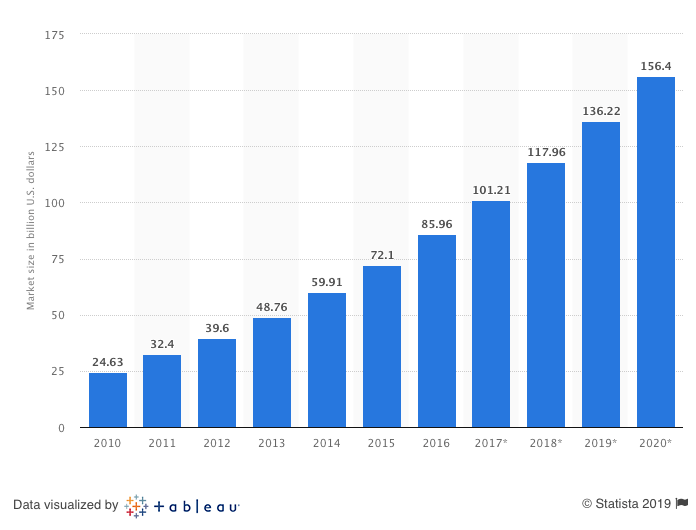
With this method, multiple servers will work together to host your website, as well as other sites. But unlike traditional shared hosting, cloud hosting accounts for traffic spikes, so high levels of traffic to your site or other sites on the same cloud shouldn’t impact anyone’s loading speed.
However, you won’t have root access for a cloud server, which means you can’t change any of the server settings or install specific software. But for those of you who have a simple website and don’t need those tech options, cloud hosting might be a good option to consider.
Who is cloud hosting for?
Cloud hosting is for websites that fall somewhere between shared hosting and a VPS.
If your site doesn’t need access to the technical side of a VPS, but want you’re anticipating high volumes of traffic and don’t want loading time to be an issue, cloud hosting is viable option.
Web hosting features
Now that you understand the four basic types of web hosting, it’s time to know what features to look for before you buy a hosting plan. These features will vary depending on the web hosting type, the hosting company, and the plan you select. Understanding these web hosting features will help you figure out how to choose a web hosting provider.
Bandwidth
Bandwidth refers to the speed of your network connection, as opposed to the transfer speed. Higher bandwidth allows more visitors to access your site at the same time while maintaining a fluid user experience.
Lower bandwidth connections will cause slow loading times, delays, and even errors.
So, take a look at the bandwidth options offered by your hosting provider. If you’re a new website, you probably don’t need the highest bandwidth right away. Find one that can meet your traffic needs and website content.
For example, if users are going to be watching videos, looking at photos, and buying items on your ecommerce shop, you’ll definitely want higher bandwidth. But if you’re just starting with a blog and don’t expect heavy traffic, you can go with a lesser plan.
Data storage and disc space
You might see some web hosting companies offering unlimited data. However, make sure you look at all the details before falling for something that sounds too good to be true. Sometimes there are hidden charges for exceeding average site usage.
Unlimited storage isn’t always the best option. I recommend picking a plan that clearly states the storage you get based on the amount of disc space that you actually need.
Customer support
Most site owners don’t think of this, but customer support should be one of the top considerations when looking for a web hosting company. Roughly 20% of web hosting clients named support as the most important feature when choosing a hosting plan — I think that number should be much higher.
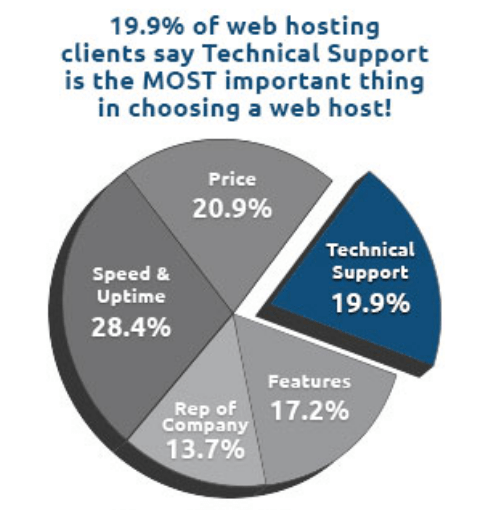
Why?
Hopefully, you don’t have any problems. But in the event you need some help or have time-sensitive questions that need to be addressed, you want to know that your web host is available and at your service.
Read reviews online from their existing clients to see how well they handle customer service communication and response time before you proceed with a plan. It’s also helpful when web hosting companies offer other resources, such as video tutorials or extensive guides and FAQ sections on their website.
Domains
The majority of the best web hosting businesses will let you create multiple domain names under the same account. So if you’re planning to host several websites through the same hosting service, this is definitely something you’ll want to look into before you get started.
It’s easier to manage everything this way. Having to set up a new account for each domain can be a pain.
For those of you that still need to buy a domain name, you can consider using a web host that allows you to purchase domains through their platform, but I recommend keeping these two things separate in case you have to switch hosts later on, your domain won’t be tied to your old host.
SSL certification
SSL stands for “secure socket layer.” Basically, this certification adds encryption to your website to protect your personal information, as well as personal information of your site’s visitors.
There are different types of SSL certificates. Some are for businesses, while others are made for individuals. Major website hosting services will offer an SSL certificate, but they can also be provided by third-party security companies.
If a website hosting company doesn’t offer SSL certificates or doesn’t have a strong SSL certificate, you may want to consider an alternative option. It’s also worth noting that transport layer security (TLS) is an alternative to SSL. This gives you more security, but it’s not as popular or readily available as SSL certificates.
You may not need more than just a couple of company email addresses right now. However, as your website grows, you may want more. That’s why I think it’s important to look for web hosting services that offer multiple email addresses with your domain name. You could always get these email features through a third-party, but it’s much easier to handle everything in the same place.
Ecommerce software
If you’re going to be selling products through your website, proper ecommerce software needs to be a priority when you’re looking for the best web hosting option. You need to be sure that your plan either supports the software that you plan to use, or comes with ecommerce software that you can implement on your site.
It’s worth noting that ecommerce software is not considered a standard feature, so shop around and make sure your web host has what you need to operate your ecommerce platform accordingly.
Uptime
For the most part, you’ll see the majority of web hosting companies offering 99.9% uptime. However, don’t assume anything.
Usually, those services don’t include scheduled downtimes in the percentages they advertise. So again, it’s best to read reviews and see if their clients are experiencing lots of downtime.
If visitors can’t access your site, it’s going to be a big problem for your business. The best websites have a high uptime percentage.
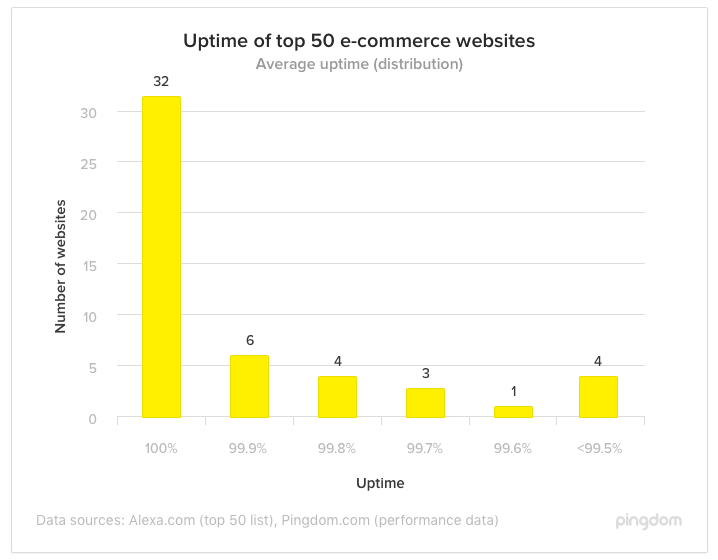
The cost of downtime can add up quickly. If users are experiencing problems on your website and can’t access content, they will leave and may not come back.
Backups
I do not recommend web hosting services that don’t offer backups. This is one of the most important web hosting features, but it’s often overlooked.
All of your website and company files should be backed up appropriately on the hosting server. You should be backing them up on your own as well, but it’s nice to know that you have this data secured by the hosting company.
Advertising credits
Some web hosts offer advertising credits as an incentive for buying a plan. Here’s an example from Bluehost.
Depending on the company you use for hosting, they’ll let you apply those credits to platforms like Google AdWords. I highly recommend taking advantage of any advertising credits you’re given.
Web hosting costs
So how much is all of this going to cost you? I’m sure this is your next logical question.
I know it’s not the answer you’re looking for, but the real answer is: It depends. Refer back to the car analogy that I gave you earlier. You could buy a new car for a few thousand dollars, or a hundred thousand dollars depending on the brand, type, and features. Well, the same goes for your web hosting service. The price can range anywhere from less than $10 per month to hundreds of dollars per month.
If you’re going to get a shared server with low bandwidth, poor support, and no added software, it’s going to be pretty inexpensive. Even the best shared hosts with great support will run you less than $10 per month; under $5 per month for the initial contract. But if you want a dedicated server, ecommerce software, unlimited email addresses, backups, and multiple domains, you can expect to pay a premium price.
The majority of us fall somewhere in between these two extremes. Just be aware that cheaper isn’t always the best option. You need to understand the hidden costs of website hosting and how these costs will change as your website grows.
Conclusion
Your website needs to be hosted to be online. There is simply no way around it.
But that doesn’t mean you should rush into a web hosting plan without doing your research first.
First, decide which type of web hosting type is best for your situation. Then, determine the web hosting features you want. Once you know the answer to these questions, look for a reputable web hosting service that meets the requirements you’re looking for.
Don’t be intimidated by web hosting. Use this beginner web hosting guide as a reference, and let me know if you have any additional questions.
What type of web hosting server are you planning to use for your website?
Source Quick Sprout http://bit.ly/2DxNBy9

 Everyone needs a little
Everyone needs a little 



